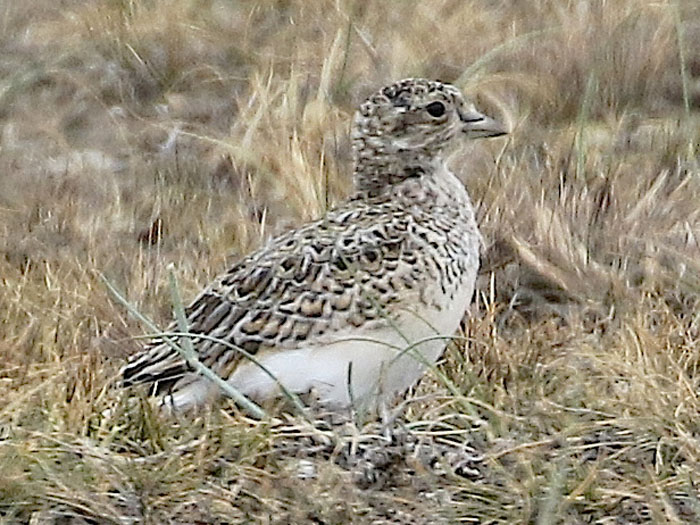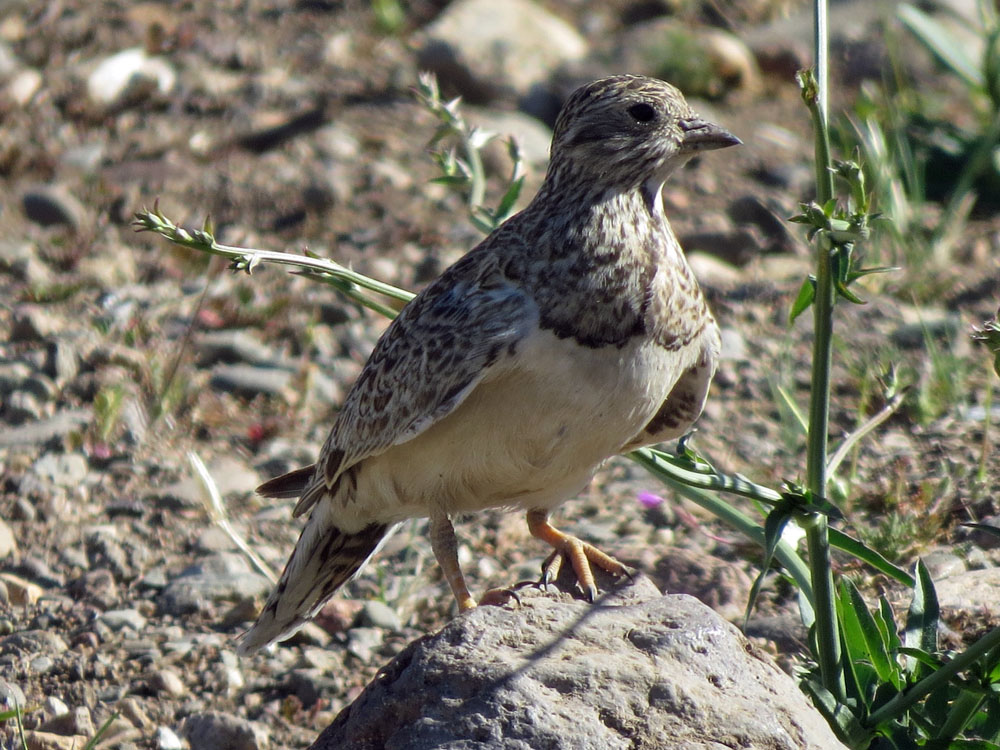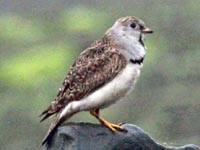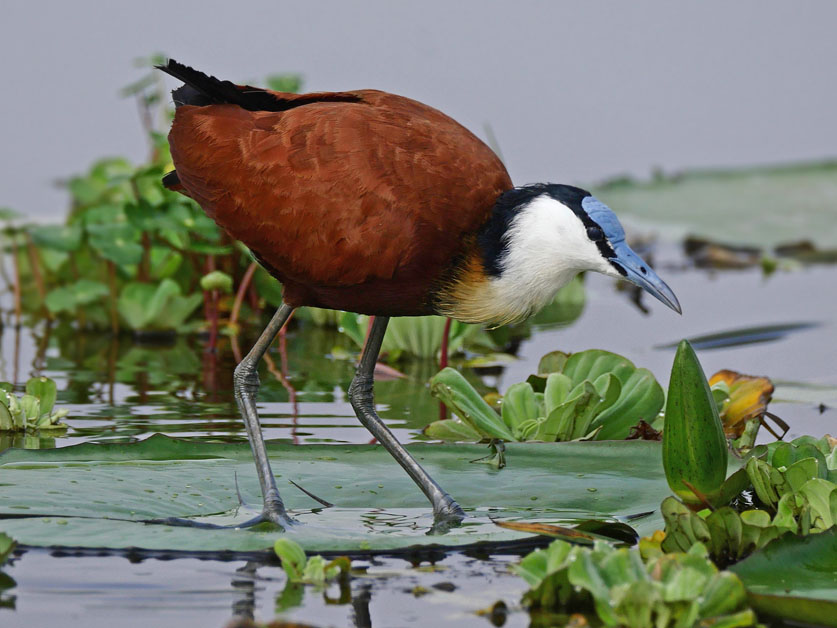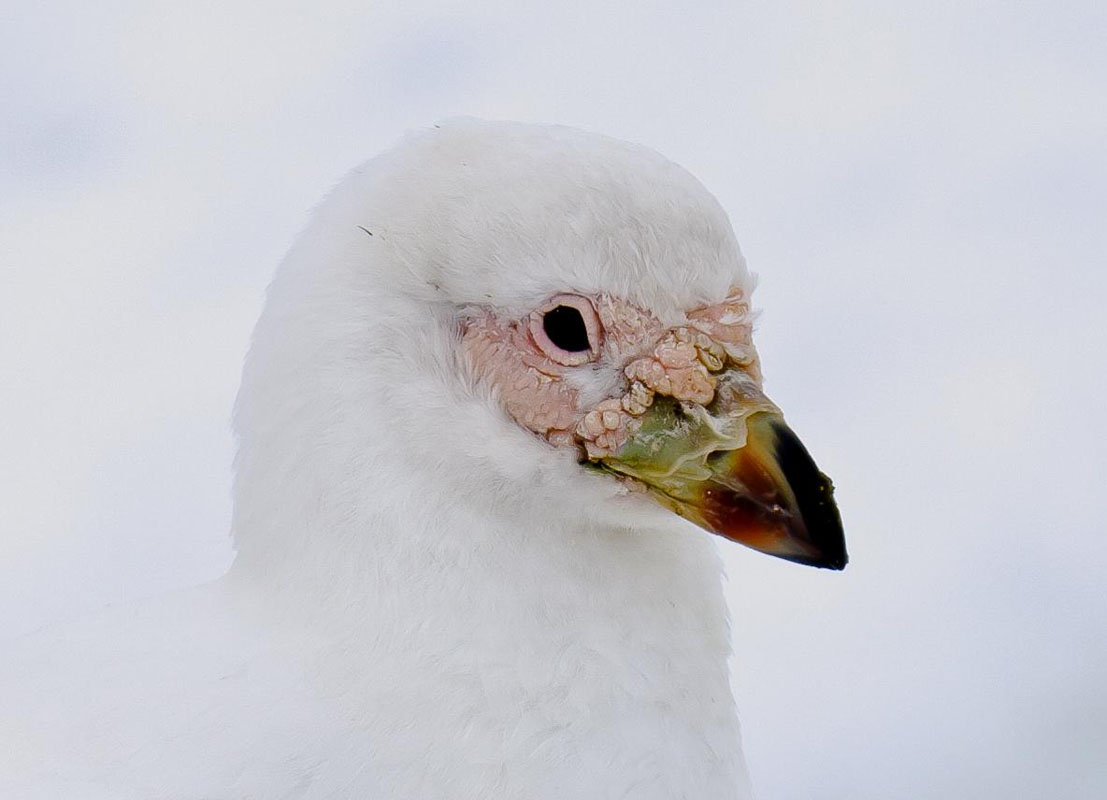THE WORLD BIRDS - An Online Bird Book
SHOREBIRDS
jacanas
Order Charadriiformes Family Jacanidae
SHOREBIRDS
Most Shorebirds walk along shores probing for food with their thin sensitive bills. Bill length varies considerably so differing species can work the same shore and obtain different
food supplies. Shorebirds include sandpipers, godwits, stilts, oystercatchers, plovers, and many more. Shorebirds belong to the Charadriiformes order which also includes the Gulls
and Allies.
Note: the term Shorebirds is used in the Americas; elsewhere "waders" is used. We will reserve "waders" for herons and allies.
Some Charadriiformes families:
Burhinidae: thick-knees; Charadriidae: small plovers, lapwings; Glareolidae: courses, pratincoles; Haematopodidae: oystercatchers
Jacanidae: jacanas; Recurvirostridae: avocets, stilts; Scolopacidae: small bill sandpipers, large bill sandpipers.
Note: the term Shorebirds is used in the Americas; elsewhere "waders" is used. We will reserve "waders" for herons and allies.
Some Charadriiformes families:
Burhinidae: thick-knees; Charadriidae: small plovers, lapwings; Glareolidae: courses, pratincoles; Haematopodidae: oystercatchers
Jacanidae: jacanas; Recurvirostridae: avocets, stilts; Scolopacidae: small bill sandpipers, large bill sandpipers.
jacanas
Order Charadriiformes Family Jacanidae
Jacanas are found worldwide within the tropical zone. They have huge feet which enable them to walk on floating vegetation in the wetlands that are their preferred habitat. There are 3 front facing toes and one faces to the rear. The neck is long and the bill long and pointed. This combination helps them stretch out and seize their favorite prey - aquatic insects. They will also eat seeds, mollusks, small fish. They are good swimmers and can even swim under water to avoid predators. On the otherhand, they are poor fliers.
The female jacana is usually considerably larger than the male. He is responsible for building the nest which is flimsy on floating vegetation. He also does the incubation and takes care of the chicks. She, being free of most parenting tasks usually takes more than one mate and supplies more tha one nest with eggs. The are precocial, that is, well developed when born - they can walk and swim on their first day. The lesser jacana is an exception as the female is monogamous and helps in the rearing of the young.
Genus Actophilornis
Jacana,_African Actophilornis africanus
Description: The African jacana has mainly chestnut plumage, It has a black rear-crown, nape, eye-line, and wingtips. Except for the narrow black nape, the neck is white. Its blue bill extends up to a frontal shield. The legs are grey. The African jacana is up to 31 cm long. The female mates with multiple males, and only the male incubates and takes care of the chicks. The similar Madagascar jacana has a white nape and black fore-neck. The range of the African jacana and Madagascar jacana do not overlap.
Range: Sub-Saharan Africa.
Habitat: Shallow freshwater wetlands.
Diet: Aquatic insects that are picked from floating vegetation. Also seeds.
Conservation status: Least Concern.
Image by: 1, 2) Dick Daniels - Tampa's Lowry Park Zoo 3) Chris Eason 4) dBerliner 5) Arno_MeintjesRange: Sub-Saharan Africa.
Habitat: Shallow freshwater wetlands.
Diet: Aquatic insects that are picked from floating vegetation. Also seeds.
Conservation status: Least Concern.
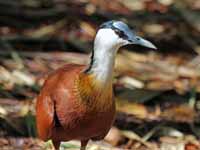

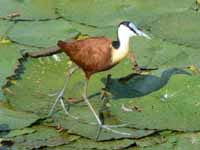

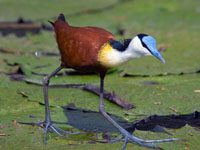
Jacana,_Madagascar Actophilornis albinucha
Description: The Madagascar jacana has mainly chestnut plumage, It has a white rear-crown and nape. The face, throat, and upper-breast are black. This is the only jacana on Madagascar. The Madagascar jacana is up to 31 cm long.
Range: Madagascar.
Habitat: Shallow freshwater wetlands.
Diet: .Aquatic insects that are picked from floating vegetation. Also seeds.
Conservation status: It is listed as Endangered because of filling of wetlands for agriculture.
Range: Madagascar.
Habitat: Shallow freshwater wetlands.
Diet: .Aquatic insects that are picked from floating vegetation. Also seeds.
Conservation status: It is listed as Endangered because of filling of wetlands for agriculture.
Image by: 1) Pat and Keith Taylor - near Ankarafantsika National Park 2) Amy_McAndrews 3) Zieger_M
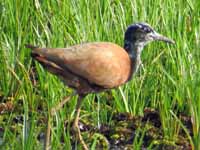
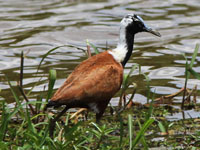
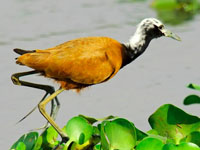
Genus Hydrophasianus - 1 species
Jacana,_Pheasant-tailed Hydrophasianus chirurgus
Description: The breeding pheasant-tailed jacana has brown upperparts, white wings, and black underparts. In flight the wings show a black border from the flight feathers. . It has a white head, and fore-neck. The light golden hind-neck is attractive and distinctive as is its long black tail. The legs are grey. The nonbreeding adult has a brown nape. The underparts are white except for a dark brown stripe on the neck that extends to the breast as a brown necklace. It does not have a long tail. The pheasant-tailed jacana is from 40 to 60 cm, with much of the longer length due to its tail in the breeding season.
Range: Indian Subcontinents, south China, Southeast Asia.
Habitat: Shallow freshwater wetlands.
Diet: Aquatic insects that are picked from floating vegetation. Also seeds.
Conservation status: Least Concern.
Image by: 1) Lin_Sun_Fong 2) JM_Garg- India 3) Werner Witte - Sri Lanka 4) Ainus 5) David_Cook - Sri LankaRange: Indian Subcontinents, south China, Southeast Asia.
Habitat: Shallow freshwater wetlands.
Diet: Aquatic insects that are picked from floating vegetation. Also seeds.
Conservation status: Least Concern.
1) Juvenile 2) Nonbreeding 3 - 5) Breeding
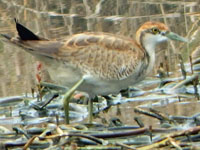



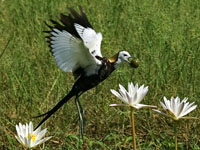
Genus Irediparra - 1 species
Jacana,_Comb-crested Irediparra gallinacea
Description: The comb-crested jacana has grey-brown back, and wings. It has a fleshy red wattle covering its forehead and crown. The rear-crown is black and the face plus throat are white. It has a black breast-band and white belly. The female is similar to the male but considerably larger.
Range: Borneo, other Indonesian Islands, Philippines, New Guinea, Northern Australia.
Habitat: Shallow freshwater wetlands.
Diet: Aquatic insects that are picked from floating vegetation. Also seeds.
Conservation status: Least Concern.
Image by: 1) SunPhlo 2) GDW.45 - Australia 3) Djambalawa 4) Geoff_WhalanRange: Borneo, other Indonesian Islands, Philippines, New Guinea, Northern Australia.
Habitat: Shallow freshwater wetlands.
Diet: Aquatic insects that are picked from floating vegetation. Also seeds.
Conservation status: Least Concern.
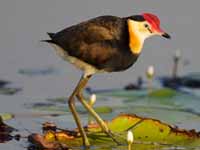
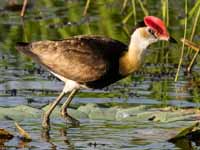
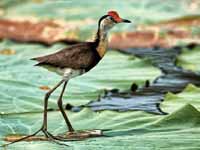
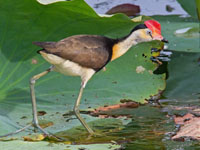
Genus jacana
Jacana,_Northern jacana spinosa
Description: The northern jacana has a dark brown body; black head and neck; yellowish bill with white base. There is a yellow frontal shield on the forehead. The female is about twice as large as the male. They average about 24 cm long.
Range: Southwest USA, Mexico to western Panama, Caribbean.
Habitat: Shallow freshwater wetlands. Also briefly visits drier grasslands.
Diet: Aquatic insects that are picked from floating vegetation. Also mollusks, small fish, land based insects, seeds.
Conservation status: Least Concern.
Image by: 1) Hans Switzer 2) Dick Daniels - Jamaica 3) Paul_Kehrer - Costa Rica 4) Benjamin_KeenRange: Southwest USA, Mexico to western Panama, Caribbean.
Habitat: Shallow freshwater wetlands. Also briefly visits drier grasslands.
Diet: Aquatic insects that are picked from floating vegetation. Also mollusks, small fish, land based insects, seeds.
Conservation status: Least Concern.
1) Juvenile
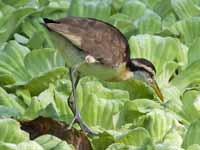
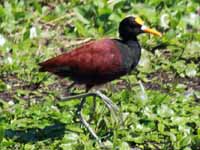
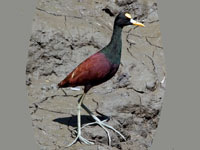
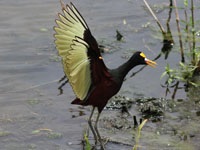
Jacana,_Wattled jacana jacana
Description: The wattled jacana has a chestnut back and wing coverts. It has black breast, neck, and head. The bill is yellow and there is a red frontal shield plus a red wattle. The juvenile has white underparts, neck, and supercilium. The female may be almost twice as large as the male.
Range: Western Panama to much of South America. Overlaps with northern jacana in western Panama.
Habitat: Shallow freshwater wetlands.
Diet: Aquatic insects that are picked from floating vegetation. Also seeds, mollusks, small fish.
Conservation status: Least Concern.
Image by:1) Dario Sanches - Brazil 2, 3, 4) Dick Daniels - Pedasi, Panama 5) Geoff
Gallice - Ecuador 6) Juan_ZamoraRange: Western Panama to much of South America. Overlaps with northern jacana in western Panama.
Habitat: Shallow freshwater wetlands.
Diet: Aquatic insects that are picked from floating vegetation. Also seeds, mollusks, small fish.
Conservation status: Least Concern.
1, 2 Juvenile 3) Left to right: juvenile, adult male, maturing juvenile female 4 - 6) Adult
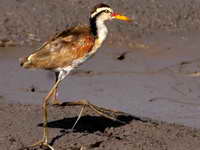



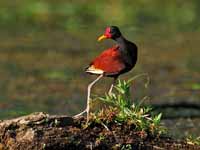
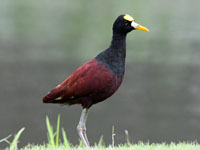
Genus Metopidius - 1 species
Jacana,_Bronze-winged Metopidius indicus
Description: The bronze-winged jacana has mainly black plumage that can exhibit areas of glossy blue in sunlight.The wings are bronze-brown. There is a bold white supercilium that extends to the nape. It has a short tail with a black terminal band. The bill is yellow-green and there is a reddish-purple frontal shield. The bronze-winged jacana is about 30 cm long with the female considerably longer than the male.
Range: India, southeast Asia, Indonesia.
Habitat: Wetlands with leafy floating vegetation.
Diet: Aquatic insects and vegetation.
Conservation status: Least Concern.
Image by: 1) Shrikant Rao - Bangalore 2, 3) JM_Garg - India 4) Dave_Curtis 5) blank whote - Bangalore Range: India, southeast Asia, Indonesia.
Habitat: Wetlands with leafy floating vegetation.
Diet: Aquatic insects and vegetation.
Conservation status: Least Concern.
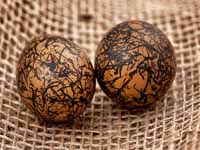
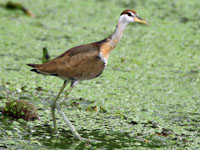

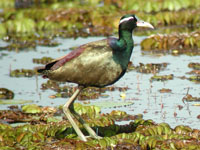
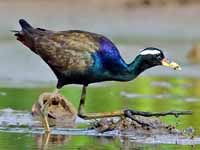
Genus Microparra - 1 species
Jacana, Lesser Microparra capensis
Description: The lesser jacana has greyish-brown upperparts. It has a dark crown, cinnamon forehard, and a white face with a black eye-line. The underparts are white. At 15 to 16 cm long, it is by far the smallest jacana. And it is the only jacana with the female being monogamous and participating in incubation and feeding of the young. She is only slightly larger than the male.
Range: Africa.
Habitat: Wetlands with emergent vegetation.
Diet: Insects which it finds while walking on the emergent vegetation; also will capture prey from vegeation while swimming. .
Conservation status: Least Concern.
Image by: 1) Benjamin Hollis - Botswana Derek_Keats - Botswana 3, 4) Jerry Oldenettel - Botswana Range: Africa.
Habitat: Wetlands with emergent vegetation.
Diet: Insects which it finds while walking on the emergent vegetation; also will capture prey from vegeation while swimming. .
Conservation status: Least Concern.
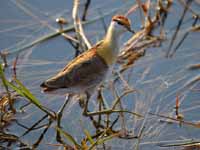
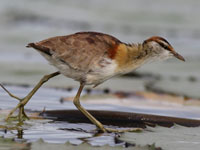
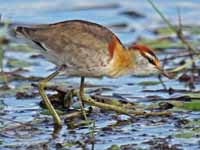

Order Charadriiformes Family Chionididae - 1 genus
There are only two sheathbills species and they are very similar to each other. They are named for the horny sheath at the base of their bills. Sheathbills are found in the Antarctic and are the only Antarctic birds without webbed feet. Probably because of the snowy environment, they are almost entirely white. The species can be differentiated by their bills. They are bold and will take penguin eggs, chicks, or steal food from young penguins. In fact, sheathbills usually breed in penguin colonies so they will have an ample supply of food. Because they do not have webbed feet and do not swim, they rely on others to first gather the food. Sheathbills practice their thievery on foot, rarely flying except when they migrate.
Genus Chionis
Sheathbill,_Black-faced Chionis minor
Description: The black-faced sheathbill has white plumage. It has a black bill and black caruncles (fleshy bumps) at the base of the bill. There are pink eye-rings. The similar snowy sheathbill has black only on the tip of its bill. The black-faced sheathbill is 38 to 41 cm long.
Range: Subantarctic islands.
Habitat: Coastlines; especially near bird and penguin colonies.
Diet: Omnivores, eating what is available. Vegetation, eggs, chicks, carrion, garbage.
Conservation status: Least Concern.
Image by: 1) Kerguelen 2) Dominique_Filippi 3) NweiderRange: Subantarctic islands.
Habitat: Coastlines; especially near bird and penguin colonies.
Diet: Omnivores, eating what is available. Vegetation, eggs, chicks, carrion, garbage.
Conservation status: Least Concern.
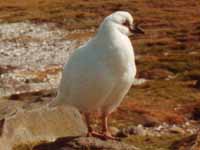
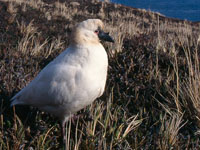

Sheathbill, Snowy Chionis albus
Description: The snowy sheathbill is pure white except for its pink warty face and its black-tipped bill. It is up to 41 cm long. The similar black-faced sheathbill has a black bill.
Range: Antarctic Region, southern South America.
Habitat: Penguin colonies while breeding; coasts.
Diet: Omnivores, eating what is available. Vegetation, eggs, chicks, carrion, garbage. .
Conservation status: Least Concern.
Image by: 1) David Jensen - Antartica 2) David_Cook 3) Charlie Westerinen - Port Lockroy, Antarctica 4) Colin ScottRange: Antarctic Region, southern South America.
Habitat: Penguin colonies while breeding; coasts.
Diet: Omnivores, eating what is available. Vegetation, eggs, chicks, carrion, garbage. .
Conservation status: Least Concern.
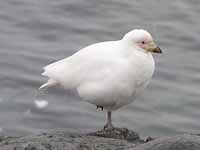
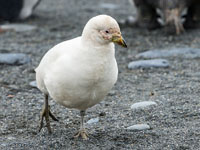
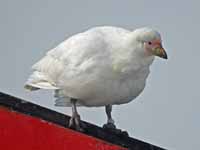
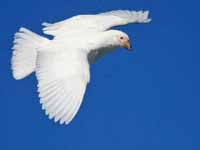
Order Charadriiformes Family Pedionomidae
Plains-wanderer Pedionomus torquatus
Description: The male plains-wanderer has light brown upperparts and fawn-white underparts with black spots, Female has darker brown upperparts. She has a white spotted black collar and a large rufous breast spot. The male plains-wanderer is 15 to 19 cm long with the female larger than the male. The resemble quail, are well camoflauged, hide when they feal threatened, and rarely flay as they are poor fliers. The male is the main incubator of the eggs.
Range: Australia.
Habitat: Grasslands.
Diet: Insects, spiders, seeds.
Conservation status: It is listed as Critically Endangered because of conversion of grasslands to outher uses.
Image by: 1, 3) Patrick_K59 2) Nik_Borrow 4) David CookRange: Australia.
Habitat: Grasslands.
Diet: Insects, spiders, seeds.
Conservation status: It is listed as Critically Endangered because of conversion of grasslands to outher uses.
1, 2) Female 3, 4) Male
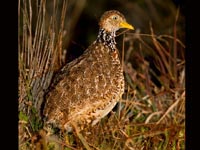
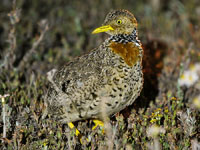
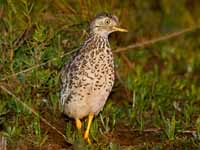
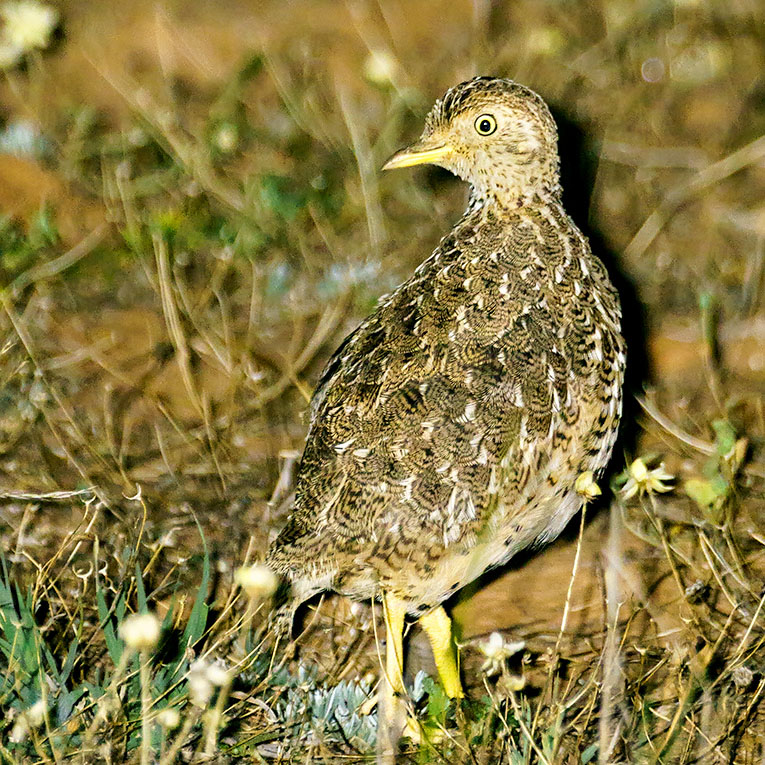
Order Charadriiformes Family Rostratulidae
Painted-Snipes resemble the True Snipes of family Scolopacidae, but they are not related. Yet another example of convergent evolution. Their closest relatives are jacanas, seedsnipes, and the plains wanderer.
Painted-snipe have a long bill. The female has more striking plumage than the male and she is slightly larger. They are found in freshwater marshes and swamps where they eat insects, seeds, crustaceans, snails and worms.
Genus Nycticryphes - 1 species
Snipe,_South_American_Painted- Nycticryphes semicollaris
Description: The South American painted-snipe has dark grey-brown upperparts. It has a white median-crown stripe and white stripes from either shoulder that meet at the tail, thus forming a 'V'. The neck and breast are dark chestnut while the belly is white. The long bill is slightly down-curved. The sexes are similar in appearance, but the female is slightly larger. Unlike the other 2 painted-snipes, the South American painted-snipe is monogamous.
Range: Southern South America .
Habitat: Freshwater wetlands.
Diet: Insects, seeds, crustaceans.
Conservation status: Least Concern.
Image by: 1) J_Simon_Tagtachian Range: Southern South America .
Habitat: Freshwater wetlands.
Diet: Insects, seeds, crustaceans.
Conservation status: Least Concern.
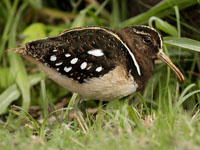
Genus Rostratula
These two painted-snipes are similar, and were once considered to be of the same species. In both cases the female often has multiple partners. The smaller and duller male incubates the eggs and raises the chicks.
Snipe,_Australian Painted- Rostratula australis
Description: The female Australian painted-snipe has a brown head, neck and breast. There are thin white eye-rings plus a wider white eye-line emanating from the rear of the eye. On the lower part of the breast there is a bold white breast-band that wraps up to the shoulders and then travels roughly parallel down the back. It has a white belly. The male is generally slightly smaller, grey-brown instead of brown, and has small white spots on the wings. The Australian painted-snipe is from 24 to 30 cm long.
Range: Eastern Australia.
Habitat: Freshwater wetlands.
Diet: Insects, seeds, crustaceans, worms, mollusks.
Conservation status: It is listed as Endangered because the population has declined substantially due to wetland drainage.
Image by:1, 3, 4) Oystercatcher - Kellys Swamp at the Jerrabomberra Wetlands in Canberra 2) Tom_TarrantRange: Eastern Australia.
Habitat: Freshwater wetlands.
Diet: Insects, seeds, crustaceans, worms, mollusks.
Conservation status: It is listed as Endangered because the population has declined substantially due to wetland drainage.
1, 2) Female 3, 4) Male
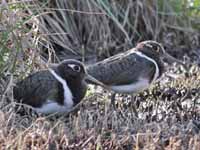
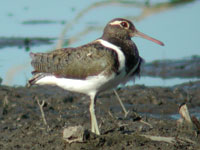
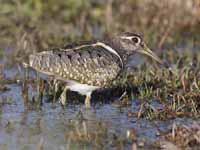
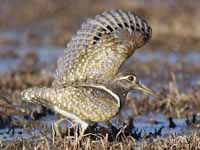
Snipe,_Greater Painted- Rostratula benghalensis
Description: The female greater painted snipe has green upperparts. Its neck and throat are chestnut. There are thin white eye-rings plus a wider white eye-line emanating from the rear of the eye. On the lower part of the breast there is a bold white breast-band that wraps up to the shoulders and then travels roughly parallel down the back. On the back the white lines becomes tan. The male is paler, greyer, and smaller. The greater painted snipe is up to 28 cm long.
Range: Asia, Africa.
Habitat: Freshwater wetlands.
Diet: Insects, seeds, crustaceans, worms, mollusks.
Conservation status: Least Concern.
Image by: 1) Charles Lam 2) Frans_Vandewalle 3) Frankie Chu 4) Ian White - Botswana 5) Andi_LiRange: Asia, Africa.
Habitat: Freshwater wetlands.
Diet: Insects, seeds, crustaceans, worms, mollusks.
Conservation status: Least Concern.
1, 2) Female 3 - 5) Male
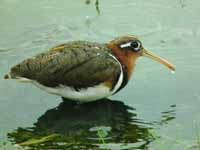
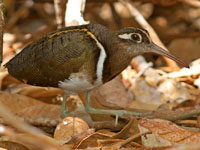
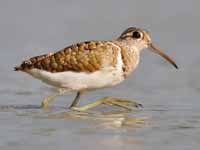
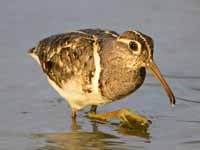
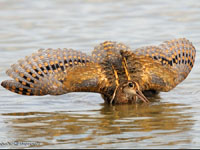
Order Charadriiformes Family Thinocoridae
Seedsnipes are in the South America in the Andes region as well as Patagonia. They inhabit a variety of harsh environments, including grasslands, grass steppes, semi-arid deserts and alpine habitats. They lay their 2 to 3 eggs in a shallow scrape on the ground. Seedsnipes do not resemble snipes! Instead these plump birds resemble ptarmagins which, although they are unrelated, fill the same ecological niche in the far northern hemisphere. Even though they are sometimes referred to as waders, that should not be taken to imply that seedsnipes are commonly found in water are most other members of the charadriiformes order. Their short legs are not designed for wading. And their short bill is not snipe-like or designed for probing in mud. Seedsnipes cloest relatives may be the plains jacanas, and painted snipes.
The nest is formed in a shallow scraped out area and lined with plan material. There are usually 4 eggs. The chicks are precocial, feathered at birth and able to run aound during their first day and even feed themselves.
Genus Attagis
Seedsnipe,_Rufous-bellied Attagis gayi
Description: The rufous-bellied seedsnipe has scalloped plumage with the scallop pattern tighter on the underparts. The upperparts are reddish brown and the underparts are paler with the breast also reddish brown and the belly pink. It has short legs and resembles a large dove or partridge. It is the largest seedsnipe with a length of 27 to 32 cm. The sexes are similar.
Range: Ecuador to Argentina.
Habitat: Highlands up to 4000 meters. It can withstand cold temperatures, similar to the ptarmagins of North America. Prefers areas with ground vegetation such as bogs, but will also frequent rocky areas.
Diet: Plant material such as buds; also seeds.
Conservation status: Least Concern.
Image by: 1) Carlo_Castellani - Bolivia 2) Nigel_Voaden - Ecuador 3) Nick Athanas - Chile 4) Francesco Veronesi - EcuadorRange: Ecuador to Argentina.
Habitat: Highlands up to 4000 meters. It can withstand cold temperatures, similar to the ptarmagins of North America. Prefers areas with ground vegetation such as bogs, but will also frequent rocky areas.
Diet: Plant material such as buds; also seeds.
Conservation status: Least Concern.
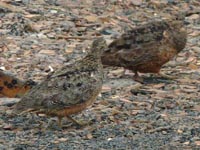
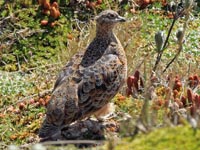
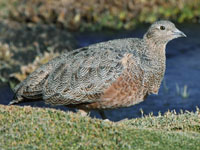
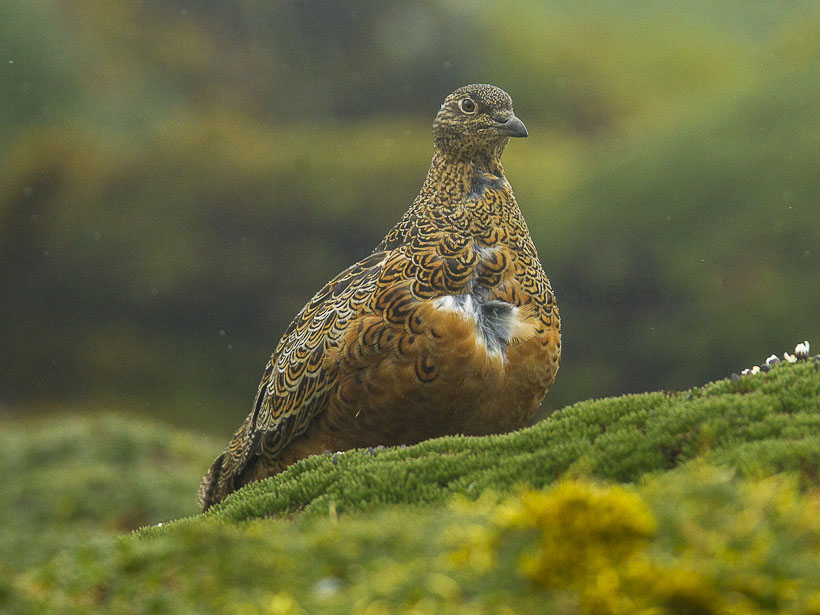
Seedsnipe,_White-bellied Attagis malouinus
Description: The white-bellied seedsnipe is similar in shape to the rufous bellied seedsnipe. It has scalloping over its upperparts and upper-breast. The lower-breast and belly are white. The white-bellied seedsnipe is 26 to 29 cm long.
Range: Southwest Argentina, Tierra del Fuego.
Habitat: Up to 2000 meters, which is lower than the rufous-bellied seedsnipe attains, but just as cold because of its more southern locations. Found in locations with low plants
Diet: Unknown.
Conservation status: Least Concern.
Image by: 1) 2) Luke_Seitz, Sebastian_Saiter_VillagranRange: Southwest Argentina, Tierra del Fuego.
Habitat: Up to 2000 meters, which is lower than the rufous-bellied seedsnipe attains, but just as cold because of its more southern locations. Found in locations with low plants
Diet: Unknown.
Conservation status: Least Concern.
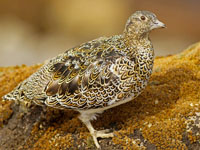
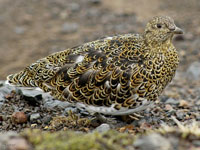
Genus Thinocorus
Seedsnipe,_grey-breasted Thinocorus orbignyianus
Description: The male least seedsnipe has cinnamon buff vermiculated upperparts. The head, neck, and upper-breast are grey. It has a white throat with black border. The lower-breast and belly are white. The female's head and breast resemble her upperparts. The least seedsnipe is 19 to 24 cm long.
Range: Argentina, Bolivia, Chile, Peru.
Habitat: In the Andes in areas with low grass, favoring land near bogs.
Diet: Buds and leaves of plants.
Conservation status: Least Concern.
Image by: 1) Murray_Foubister 2) Opisska - Argentina 3) Pablo_Caceres_Contreras - Chile 4) Nick Athanas - Argentina Range: Argentina, Bolivia, Chile, Peru.
Habitat: In the Andes in areas with low grass, favoring land near bogs.
Diet: Buds and leaves of plants.
Conservation status: Least Concern.
1) Female 2 - 4) Male

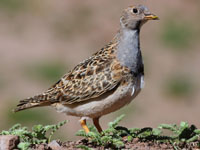
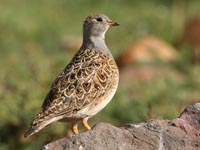
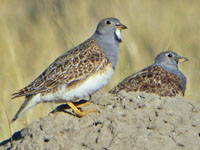
Seedsnipe,_Least Thinocorus rumicivorus
Description: The male least seedsnipe has brown upperparts with scalloping. It has a grey face, neck, and breast. There is a black line at center of the throat which forms an inverted T. The legs are yellowish-green and the bill is ashy colored.The females has the grey replaced with brown scalloped plumage. The least seedsnipe is up to 19 cm long which makes it the smallest of the sandsnipes. Only the female incubates the eggs.
Range: Western South America from Peru to Argentina. Also southern South America.
Habitat: Arid evironments .
Diet: Seeds, buds, and leaves of plants.
Conservation status: Least Concern.
Image by: 1) Under_the_Same_Moon 2) Diego Carus 3) Dominic_Sherony 3) Nick Athanas - ArgentinaRange: Western South America from Peru to Argentina. Also southern South America.
Habitat: Arid evironments .
Diet: Seeds, buds, and leaves of plants.
Conservation status: Least Concern.
1, 2) Female 3, 4) Male
